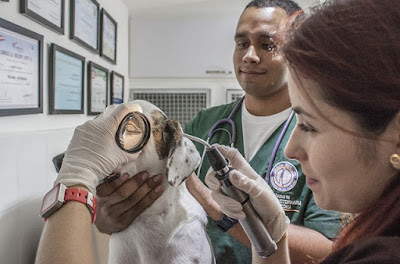We suggest you consider adopting a puppy (or an adult) from a shelter or rescue group before buying one. But if your heart's set on a purebred puppy, the first step is to find a breeder who knows what she's doing. Unlike pet stores and unscrupulous breeders, good breeders are careful to breed only healthy dogs with good temperaments. This means that any puppy you get from them has a better chance of turning out to be a good family pet. They also know how to raise their puppies in a way that prepares them for life as a family dog.
There are plenty of breeders out there who are uninformed, unscrupulous, or both. Take your time and be picky about finding the right one.
Where to start
Ask your vet, visit dog shows, or contact local breed clubs to get recommendations on good local dog breeders. The American Kennel Club also offers breeder referralsfor all the recognized breeds. And of course, if you know anyone with a fabulous dog, ask where she got the pup.
Questions to ask a breeder (see the article Becoming a Dog Breeder)
Talk to and visit several breeders, so you get a sense of what separates the really dedicated breeder from the so-so one.
Here are some of the questions that will help you suss that out:
Where do the puppies live? The answer should be "in the house with the family." A puppy who's born into family life has a better shot at growing up relaxed and friendly. A pup isolated from humans in a backyard, garage, or basement is more likely to wind up shy or aggressive.
How often are the puppies handled? Puppies should be handled by lots of different people beginning very early in life so they'll grow up to be comfortable and safe around humans. Ideally, the breeder throws regular puppy parties, inviting lots of guests over to play with and handle the pup. Five minutes of daily pats on the head by the breeder won't cut it.
Can I meet the parents? Meeting the father may not be possible, but you should certainly meet the mother. A puppy's parents give you better insight into her future personality than does her breed. A friendly, well-behaved Mamma or Papa dog is a good sign, both that you've found a good litter and a good breeder.
How many litters do you raise a year? A breeder with just one or two litters a year will have the time to give them the care and handling they need, and to find them good homes. Each female dog should be bred no more than once a year.
Can I have copies of the health clearances? Many breeds are prone to certain genetic conditions. The breeder should offer health clearances--documentation from an independent agency, such as the Orthopedic Foundation for Animals or the Canine Eye Registration Foundation--that the parent and grandparent dogs were tested for hereditary problems. (You'll need to do some research on your breed to find out what the parent dogs should be tested for--our breed profiles are a great place to start.)
Because some genetic conditions don't show up until adulthood, health clearances aren't available for dogs younger than two years old. For that reason, a responsible breeder won't breed dogs until they're two or three years old.
Can I talk to someone who's bought a puppy from you? Good breeders should be happy to give you references; even better, they'll refer you to other breeders as well as customers.
Signs of a reputable breeder
Keep your eyes open when you're visiting breeders. Here's a check list of what to look for in a good breeder.
The dogs live inside. Puppies who are going to be family dogs should be raised inside with the family, not in a backyard, basement, or garage.
The dogs and puppies are relaxed around people. If the parent dogs and puppies seem comfortable with humans, that's a good sign that they've been properly cared for and socialized.
The place is clean. Don't worry about the dirty dishes in the sink--just make sure the dogs' living area is safe, sanitary, and that they're supplied with fresh water, beds, and toys. Is there a toilet area in the puppy's living quarters, or is it all one big toilet? If it's the former, the puppies have a head start on housetraining.
The breeder participates in dog shows or competitions. A good breeder is motivated by enthusiasm for the breed, not by making a little extra cash.
The breeder asks you to sign a spay/neuter contract. If you're buying a dog who's not going to be bred, the breeder should ask you to sign a contract promising to spay or neuter your pup, to avoid contributing to pet overpopulation.
The breeder doesn't specialize in sizes or colors that are unusual for the breed.For one thing, extremely small or extremely large dogs are more likely to have health problems. For another, trying to breed for rare colors or extreme sizes is a sign that the breeder is more interested in making money out of a sales gimmick than in producing great puppies.
T
he breeder is up-front about the breed's drawbacks, whether that means a tendency to develop certain health problems or a temperament that's not for every owner. A good breeder wants you to love and care for your new dog for his entire lifetime, and she knows that's more likely if you're well prepared.
The breeder wants to meet the whole family and welcomes you to make several visits. To make the best match, the breeder will want to meet everyone who'll be living with the puppy. And she'll want you to take the time to make the right decision; high-pressure salesmanship is a red flag.
The breeder asks you lots of questions.
This shows she wants to know exactly what kind of home her puppies are going to. She may ask who's going to be home during the day, what your dog-owning history is, and why you're interested in the breed. Don't be defensive; she's just doing her job, which is taking care of the pups she brings into the world.
The breeder will take the dog back, at any stage of the dog's life, if you're unable to care for her. A good breeder will insist on this. Again, she wants to make sure the puppies she brought into the world will always be taken care of.
The breeder won't let you take the puppy home before she's eight weeks old.Playing with her littermates teaches your puppy a lot about getting along with other dogs. A puppy who's taken away from her littermates too early is at a major disadvantage in her canine social skills.
Bottom line: Before buying a puppy, take the time to research and find a responsible breeder. Puppies from good breeders are more likely to grow up to be healthy, temperamentally sound dogs.












